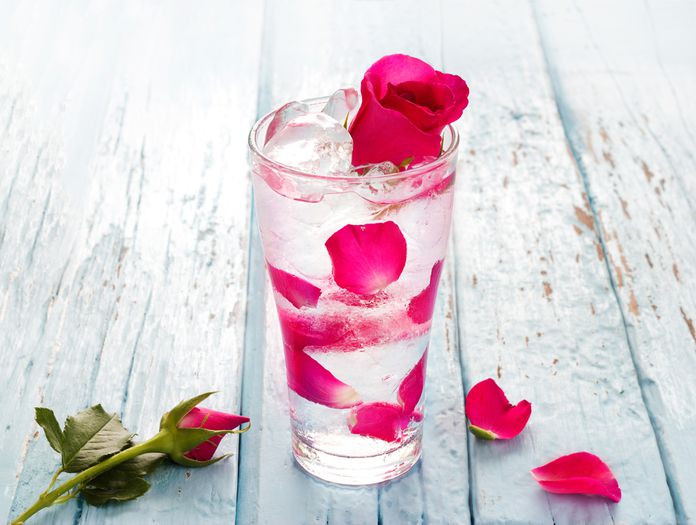I am a big fan of flower teas. I like the taste of flower tea, the aroma of it, and the look of it. Nothing beats the peaceful moment when I curl up on the couch with a glass of flower tea inhaling the steaming flowery aroma and watching the pink petals slowly sink to the bottom of the glass while listening to the raindrops pounding on the skylight. And, believe me, there is no shortage of raindrops in Seattle.
Herbal medicine uses various flowers for nutritional or therapeutic uses. Each flower has its own healing power. These are some of the flower teas I enjoy.
Stevia and flower tea
Material: Stevia with other flower tea.
Usage: Brew a few stevia leaves with a flower tea of your choice in boiling water for 5 minutes and serve.
Effect: Stevia is used as a sugar substitute in flower tea. Chinese medicine believes that stevia can eliminate fatigue, lower blood sugar, nourish level, and stimulate central nervous system.
Pagoda tree flower bud tea
Material: Dried Pagoda tree flower bud alone, or equal amount of dries Pagoda tree flower bud and green tea.
Usage: Brew the tea in boiling water for 5 minutes and serve.
Effect: Pagoda tree flower bud is a common herb in Chinese medicine. Chinese medicine believes that the herb is anti-inflammatory and analgesic and can remove heat, cool blood, stop bleeding, lower blood pressure, and strengthens blood vessels. The herb is often used in the formulations for treating blood in stool, hemorrhoids, blood in the urine, uterine bleeding, nosebleed, diarrhea, red eyes, ulcers, and sores.
Lily flower tea
Material: dried lily flower alone, or equal amount of dried lily flower and green tea. You can also add honey suckle flower.
Usage: Brew the tea in boiling water for 5 minutes and serve.
Effect: Lily flower is used in the Chinese medicine to ease cough, clear respiratory system infection, nourish lung, reduce anxiety, treat insomnia, and calm central nervous system.
Osmanthus (sweet olive) tea
Material: equal amount of dry osmanthus (sweet olive) and green tea
Usage: Brew the tea boiling water for 5 minutes and serve.
Effect: Osmanthus tea is believed to be anti-inflammatory and anti-bacterial. The team is further believed to increase the blood circulation and moisturize the skin. Chinese herbalists use this tea to treat dry skin and dry throat. .
Saffron sandalwood tea
Material: saffron, sandalwood 5 grams, 2 grams of green tea, 30 grams of brown sugar.
Usage: brew the mixture in boiling water for 5 minutes and serve.
Effect: Saffron is sweet and is rich in vitamins and bioactive ingredients. The herb is believed to nourish the blood, increase blood circulation, lower blood pressure and blood lipids, inhibition of thrombosis, and strengthen cardiovascular system. Traditional Chinese medicine uses the herb to clarify the skin and beautify the hair. Do avoid this tea before bedtime.
Rose tea
Material: Rosebuds or rose petals 3 to 5 grams, 3 grams of oolong tea, sugar or a little honey as needed.
Use: Brew the mixture in hot water for 5 minutes, add honey or sugar, and serve.
Effect: Rose tea is believed to promote blood circulation, detoxify the liver, lower blood lipids, promote weight loss, moisturize the skin, and beautify the body. Sometimes, the tea is used to treat dysmenorrhea and irregular menstruation in Chinese medicine.
Enjoy!
Dr. Connie Wan
About SGC:SGC is an R&D focused developer of nutraceutical and pharmaceutical gummy products. The company specializes in formulating Functional Gummy® products combining the wealth of the in-house knowledge in pharmaceutics, chemistry, western medicine and herbal medicine. The company provides performance gummies® inspired by Traditional Chinese Medicine including MOCCA SHOTS™, ENERGON QUBE™, FUNTIONAL FRUIT®, and SEATTLE BEAUTY®.
To learn more, visit https://seattlegummy.com, contactinfo@seattlegummy.com,call 206-257-0464, or join at https://seattlegummy.com/be-an-informed-member/.
PERFORMANCE GUMMIES | FREE SHIPPING ON ORDERS OVER $50
- Our Story
- Locations
- Blog
- Contact
-
Newsletter
SIGN UP FOR NEWSLETTER
Signup for our newsletter to be notified about product discounts and coupons, performance and nutritional tips and latest research breakthroughs in nutrition and healthy living.
PERFORMANCE GUMMIES | FREE SHIPPING ON ORDERS OVER $50

